Parra – Les Bienveillantes
Maximilian Aue – Peter Tantsits
Una Moreau, Schwester – Rachel Harnisch
Héloïse Aue, Mutter – Natascha Petrinsky
Aristide Moreau – David Alegret
Dr Mandelbrod/Grafhorst/Kaltenbrunner – Gianluca Zampieri
Thomas Hauser – Günter Papendell
Kommissar/Clemens/Hafner/Hauptmann 1 – Michael J Scott
Kommissar Weser/Hartl/Ober/Bierkamp/Hauptmann 2 – Donald Thomson
Blobel/Hohenegg/Organist – Claudio Otelli
Quartett 1/Hilde/Frau 1 – Hanne Roos
Quartett 2/Helga/Frau 2 – Maria Fiselier
Quartett 3 – Denzil Delaere
Quartett 4/Hans/Mann/Russe – Kris Belligh
Hedwig – Sandra Paelinck
Schupo – Erik Dello, Dejan Toshev, Mark Gough
Koor Opera Vlaanderen, Symfonisch Orkest Opera Vlaanderen / Peter Rundel.
Stage director – Calixto Bieito
Opera Vlaanderen, Antwerp, Flanders, Belgium. Sunday, April 28th, 2019.
Jonathan Littell’s novel, Les Bienveillantes, was an immediate best-seller when it was published in France back in 2006, where it was awarded with the Prix Goncourt, the Grand Prix du roman de l’Académie française, and was subsequently translated into several languages. Its 1400 pages provide a fertile source of material for a theatrical work. This new opera, of which I attended the third-ever performance, marked the latest collaboration between the Catalan composer, Hèctor Parra, and his compatriot, the stage director Calixto Bieito, having previously worked on another of Parra’s operas, Wilde, in 2015. This Bienveillantes is certainly an ambitious undertaking. Scored for a large orchestra, chorus, and an extensive cast, this was a major new production for Opera Vlaanderen, produced in cooperation with Nürnberg and Madrid.
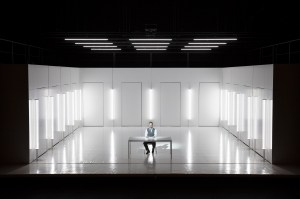
Littell’s novel caused considerable controversy because it provided an autobiographical account of a fictional Nazi, Maximilian Aue, who was involved in a number of atrocities during World War Two. Aue is also a homosexual who had an incestuous relationship with his sister, Una. The opera takes us on his journey from uptight, post-war businessman, through his reflection on his life so far and how he became used to murder, allowing his basest instincts to come to the fore.
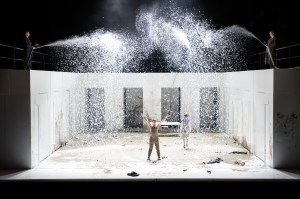
The libretto, by Händl Klaus, really does not leave anything to the imagination. There were some extremely graphic descriptions of murder, sexual experimentation with household objects, as well as seriously explicit descriptions of scatology. Yet Bieito’s staging leaves much to the imagination. Fortunately, we’re spared the sight of Aue penetrating himself with the contents of his kitchen. Instead, Bieito takes a more creative, thought-provoking angle. In a fascinating interview in the handsome program book, Bieito states ‘I want to look into the human mind and look through to the repulsiveness within’ (my translation). What he gives us is a theatrical tour de force, the descent of a man into violence and perversion. We’re introduced to Aue in a pristine, white room and, as the evening progresses, it becomes covered in mud, the walls soiled, the floor the scene of debauched rolling as characters soil their bodies with it. As a way of portraying the descent of an individual and a people into a hell of their own making, it made for a highly compelling image, yet never succumbed to the urge to provide clichéd visions of war porn, instead giving us a psychological thriller.
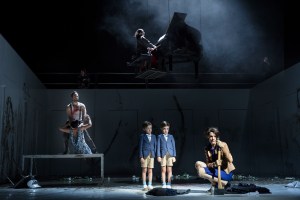
This idea, that a completely rational people could de-personalize others to the extent that it results in mass murder, is one that felt so timely. With the rise of the far right in the UK, the south of the Spanish State and elsewhere, this is a reminder that the line between fascist words and deeds is incredibly fine. As always, Bieito is a superlative director of choruses, and what was fascinating was the way in which individuals from the chorus, as a well as a vocal quartet that commented on the action, switched from being victims to the victimizing and back again. We also saw the initially upright, bourgeoise, elegantly-dressed Una allow herself to submit to her basest instincts and indulge in depraved sex with her brother.
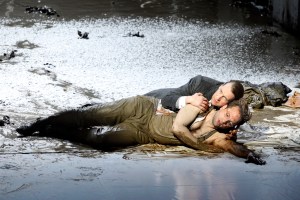
Parra’s music is an intense, highly-charged sound world. He makes frequent use of dissonant tone clusters, punctuating the textures with jagged brass sforzandos. There’s a violence to the score that compares tellingly with the matter of fact descriptions of genocide uttered by the protagonists on stage. Parra gives his score a sense of universality, with quotations from throughout the Western canon, including Bach, Bruckner, as well as Webern. Quotations from Shostakovich’s Babi Yar symphony also gave the scene set at that massacre particular poignancy. And yet, the impression I left with was that, despite the work being finely crafted, it was very much constantly full-on, lacking in light and shade, so that the cumulative effect lost its impact. There were two astounding moments that really stood out. As Aue killed his mother and step-father, a pianist, Jeanne-Minette Cilliers, was elevated above the stage, the lyricism of her playing providing a moment of beauty among the horror. Similarly, during the most sexually graphic episode of the work, as Aue described sodomizing himself with the contents of his home, Parra built the tension in the score up most grippingly, adding electronics to the orchestral line to confront us with an unimaginable perversion.
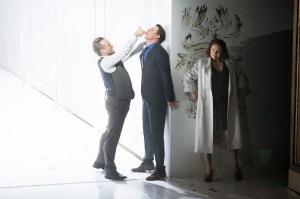
Parra gives the assembled forces a serious challenge to their teeth into. Especially to Peter Tantsits as Aue. The role is immense. Aue is on stage throughout the three and a half hour running time. His music sits relatively high, with a lot of declamatory writing sitting both on high and right in the passaggio. Indeed, the writing for all of the characters frequently takes them to the extremities of their registers. Tantsits gave so much of himself in a vocally and physically fearless performance. The libretto lists Aue as a ‘lyric tenor’ but it feels that perhaps that that could be revised to ‘dramatic tenor’. Tantsits’ Aue was very much sung off the text in a sandy tenor that carried well. Some signs of tiredness at the end of this epic evening were unsurprising given how much he had to sing and how high the role was sustained. Tantsits gave so completely of himself – his dedication was inspirational.
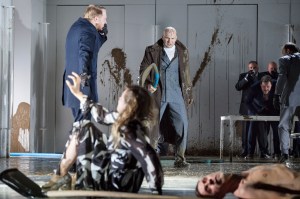
Rachel Harnisch’s soprano has filled out quite wonderfully. She dispatched her high soaring phrases with strawberries and cream tone. Her instrument really is in fabulous shape. Natascha Petrinsky was her and Aue’s mother, and dispatched her extrovert writing in a large, strident mezzo. Parra has her firing on all cylinders from her first entry and Petrinsky didn’t hold back. It was definitely loud. David Alegret sang Aristide Moreau, the step-father, in a light, narrow, high-lying tenor. As Thomas Hauser, Aue’s friend, Günter Papendell was luxury casting, his exceptionally handsome, juicy baritone was nicely dispatched.

In the remaining cast, we had a mellifluous quartet, commenting on the action. Hanne Roos capped the line in a stratospheric soprano, Maria Fiselier added spice with a fruity mezzo and Kris Belligh’s warm bass added fullness on the bottom. They were joined by Denzil Delaere whose well-placed, easily-produced tenor gave much pleasure. Les Bienveillantes is an extremely challenging work for the chorus and here Jan Schweiger’s singers showed themselves on terrific form. They handled the multiple dissonances with ease, in places pitching seemingly from the air. The sound was big and bold, some broad vibratos among the ladies adding an appropriate sense of stridency in places. The orchestra, under Peter Rundel, also gave a very good account of themselves. Rundel was a highly sensitive presence in the pit, always allowing the singers through, despite the thickness of the orchestration in places. He obtained playing of staggering accuracy from the band, the strings bringing out both the dissonance as well as the beauty of the musical quotations, with the brass and percussion offering jabs as sharp as a knife.
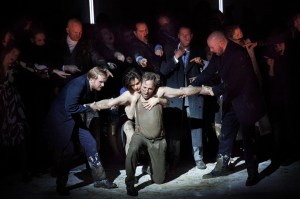
Above all, Les Bienveillantes, is a triumph for Opera Vlaanderen, both in the strength of the house forces and in the excellence of the casting, with Tantsits, in particular, giving an astounding performance. It’s a very bleak work, one that puts the darkest side of the human soul front and centre. This is a production that doesn’t provide all the answers, but instead makes us question ourselves. I do think, however, that it has issues. It takes somewhat too long to say what it needs to say, it feels in places slightly repetitive, and the constant in your face violence of the score can seem monotonous. And yet, there is boldness in its ambition. The music is extremely well crafted and we were given a bold, compelling and technically audacious staging by a master of the theatrical art. The audience gave both Parra and the cast a warm ovation at the end, particularly to Tantsits who most definitely earned it.
If you value the writing on this site, you can help expand its coverage by joining the Patreon community and helping to support independent writing on opera. Alternatively, you can support operatraveller.com with a one-off gesture via paypal.